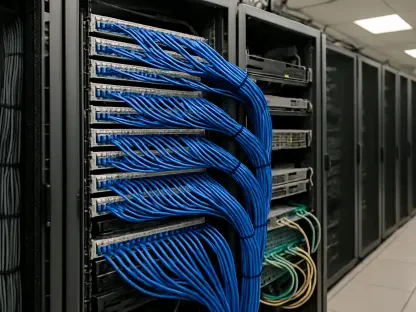In the high-stakes arena of national defense, where every second counts and the margin for error is razor-thin, artificial intelligence (AI) and edge computing are revolutionizing the way conflicts are fought and won. The U.S. Department of Defense (DoD) is at the forefront of this seismic shift, embedding these cutting-edge technologies into the very fabric of military operations at the “tactical edge”—the critical frontlines where real-time decisions determine outcomes. Far beyond a simple upgrade, this integration represents a fundamental rethinking of warfare, enabling faster, smarter, and more resilient systems in environments where traditional cloud-based infrastructures often fail due to disrupted connectivity or hostile interference. As adversaries grow more sophisticated, the urgency to adopt these innovations intensifies, positioning AI and edge computing as indispensable tools for maintaining strategic superiority in an increasingly complex global landscape.
Revolutionizing the Battlefield with Speed and Intelligence
The essence of modern warfare is being redefined by the tactical edge, a domain where edge computing processes data directly at the source, slashing delays and ensuring operational continuity in the most challenging conditions. When paired with AI, this technology transforms raw information from sensors into actionable intelligence, supporting critical functions like threat identification, logistical planning, and equipment maintenance. This combination empowers military forces to respond instantaneously to dynamic threats, a capability that is no longer a luxury but a necessity on battlefields where milliseconds can tip the scales. Autonomous systems, driven by these advancements, are becoming integral, allowing for swift, data-informed actions without reliance on distant servers or vulnerable communication lines, thus redefining the pace and precision of military engagements.
Beyond speed, the fusion of AI and edge computing fosters unparalleled resilience and autonomy in military operations, particularly in disconnected or contested environments. Imagine drones independently detecting and neutralizing targets or predictive algorithms flagging equipment issues before they escalate into mission-critical failures—such scenarios are now tangible realities. This shift away from centralized, outdated systems to a decentralized, data-driven model ensures that units can operate effectively even when cut off from broader networks. The ability to maintain mission integrity under duress marks a profound departure from traditional warfare, prioritizing adaptability as a core strength. As threats evolve, this technological backbone equips forces to anticipate and counter challenges with unprecedented agility, cementing its role as a cornerstone of future defense strategies.
Forging Alliances for Technological Dominance
Recognizing that innovation cannot be achieved in isolation, the DoD has embraced a collaborative approach, forging strategic partnerships with private-sector tech leaders to accelerate the deployment of AI and edge computing solutions. Major players like NVIDIA, with its high-performance A100 chips, and Dell Technologies, offering robust, field-ready infrastructure, are pivotal in this ecosystem, alongside specialized firms such as One Stop Systems (OSS) and Leonardo DRS. These alliances focus on delivering ruggedized systems designed to withstand the harsh realities of military environments while ensuring scalability across diverse platforms. By adopting a “commercial-first” mindset, the DoD leverages cutting-edge advancements from the private sector to maintain a decisive edge over adversaries, blending commercial ingenuity with military precision.
These partnerships are underpinned by substantial contracts and initiatives that translate technological potential into battlefield reality. For instance, OSS’s $6.5 million agreement to supply high-performance servers and Leonardo DRS’s development of an Artificial Intelligence Processor for real-time threat detection exemplify the tangible impact of these collaborations. Broader programs, such as the Joint Warfighting Cloud Capability (JWCC), alongside partnerships with companies like Google and SAIC for secure, distributed cloud systems, underscore a commitment to integrating advanced tools while prioritizing cybersecurity through zero-trust frameworks. Such efforts highlight how the DoD is not merely adopting technology but actively shaping its application to meet the unique demands of modern warfare, ensuring that innovation aligns with strategic imperatives.
Unlocking Financial Potential in Defense Technology
The financial landscape surrounding defense technology is experiencing a remarkable surge, fueled by significant DoD investments in AI and edge computing. With a $179 million allocation under the current National Defense Authorization Act (NDAA) and billions more directed toward broader modernization efforts, the sector presents a compelling opportunity for investors. Companies like OSS, with recurring revenue from DoD contracts, and NVIDIA, powering AI analytics at the edge, stand out as prime beneficiaries of this funding wave. This influx of capital signals a sustained demand for mission-critical solutions, positioning defense tech as a vital pillar of national security and a high-growth area for those looking to invest in transformative innovations that shape the future of conflict.
However, navigating this promising terrain requires a clear-eyed view of the inherent challenges, including cybersecurity vulnerabilities, interoperability issues, and the substantial costs of research and development. Despite these hurdles, the DoD’s proactive strategies—such as implementing end-to-end encryption and emphasizing system compatibility—mitigate risks and bolster confidence in long-term prospects. The pressing need for modernization, driven by escalating geopolitical tensions, further outweighs these concerns, creating a favorable environment for growth. For investors, the defense tech sector offers a unique blend of risk and reward, with the potential to support groundbreaking solutions that not only enhance military capabilities but also redefine the economic contours of national defense.
Shaping the Future of National Security
Reflecting on the strides made, it’s evident that AI and edge computing have already begun to reshape the landscape of warfare, embedding speed, autonomy, and resilience into the core of military operations. The DoD’s strategic focus on the tactical edge has marked a turning point, ensuring that forces are equipped to handle the complexities of modern threats with unmatched precision. Partnerships with private tech firms have proven instrumental, driving innovation at a pace that keeps adversaries at bay. Looking ahead, the path forward involves deepening these collaborations and scaling investments in emerging technologies to address evolving challenges. Prioritizing cybersecurity and interoperability will be critical, as will identifying new players in the defense tech space who can offer fresh perspectives and solutions. By sustaining this momentum, the foundation laid can evolve into a robust framework, securing not just battlefields but the broader realm of national defense for years to come.









